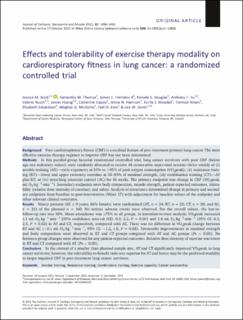| dc.contributor.author | Scott, Jessica M. | |
| dc.contributor.author | Thomas, Samantha M. | |
| dc.contributor.author | Douglas, Pamela S. | |
| dc.contributor.author | Yu, Anthony F. | |
| dc.contributor.author | Rusch, Valerie | |
| dc.contributor.author | Huang, James | |
| dc.contributor.author | Capaci, Catherine | |
| dc.contributor.author | Harrison, Jenna N. | |
| dc.contributor.author | Stoeckel, Kurtis J. | |
| dc.contributor.author | Nilsen, Tormod Skogstad | |
| dc.contributor.author | Edvardsen, Elisabeth | |
| dc.contributor.author | Michalski, Meghan G. | |
| dc.contributor.author | Eves, Neil D. | |
| dc.contributor.author | Jones, Lee W. | |
| dc.contributor.author | Herndon II, James E. | |
| dc.date.accessioned | 2022-03-22T20:41:20Z | |
| dc.date.available | 2022-03-22T20:41:20Z | |
| dc.date.created | 2021-12-03T14:56:32Z | |
| dc.date.issued | 2021 | |
| dc.identifier.citation | Journal of Cachexia, Sarcopenia and Muscle. 2021, 12(6), Side 1456-1465. | en_US |
| dc.identifier.issn | 2190-5991 | |
| dc.identifier.uri | https://hdl.handle.net/11250/2986912 | |
| dc.description | This is an open access article under the terms of the Creative Commons Attribution-NonCommercial-NoDerivs License, which permits use and distribution in any medium, provided the original work is properly cited, the use is non-commercial and no modifications or adaptations are made. | en_US |
| dc.description.abstract | Background: Poor cardiorespiratory fitness (CRF) is a cardinal feature of post-treatment primary lung cancer. The most effective exercise therapy regimen to improve CRF has not been determined.
Methods: In this parallel-group factorial randomized controlled trial, lung cancer survivors with poor CRF (below age–sex sedentary values) were randomly allocated to receive 48 consecutive supervised sessions thrice weekly of (i) aerobic training (AT)—cycle ergometry at 55% to >95% of peak oxygen consumption (VO2peak); (ii) resistance training (RT)—lower and upper extremity exercises at 50–85% of maximal strength; (iii) combination training (CT)—AT plus RT; or (iv) stretching attention control (AC) for 16 weeks. The primary endpoint was change in CRF (VO2peak, mL O2·kg−1·min−1). Secondary endpoints were body composition, muscle strength, patient-reported outcomes, tolerability (relative dose intensity of exercise), and safety. Analysis of covariance determined change in primary and secondary endpoints from baseline to post-intervention (Week 17) with adjustment for baseline values of the endpoint and other relevant clinical covariates.
Results: Ninety patients (65 ± 9 years; 66% female) were randomized (AT, n = 24; RT, n = 23; CT, n = 20; and AC, n = 23) of the planned n = 160. No serious adverse events were observed. For the overall cohort, the lost-to-follow-up rate was 10%. Mean attendance was ≥75% in all groups. In intention-to-treat analysis, VO2peak increased 1.1 mL O2·kg−1·min−1 [95% confidence interval (CI): 0.0, 2.2, P = 0.04] and 1.4 mL O2·kg−1·min−1 (95% CI: 0.2, 2.5, P = 0.02) in AT and CT, respectively, compared with AC. There was no difference in VO2peak change between RT and AC (−0.1 mL O2·kg−1·min−1, 95% CI: −1.2, 1.0, P = 0.88). Favourable improvements in maximal strength and body composition were observed in RT and CT groups compared with AT and AC groups (Ps < 0.05). No between-group changes were observed for any patient-reported outcomes. Relative dose intensity of exercise was lower in RT and CT compared with AT (Ps < 0.05).
Conclusions: In the context of a smaller than planned sample size, AT and CT significantly improved VO2peak in lung cancer survivors; however, the tolerability-to-benefit ratio was superior for AT and hence may be the preferred modality to target impaired CRF in post-treatment lung cancer survivors. | en_US |
| dc.language.iso | eng | en_US |
| dc.subject | aerobic training | en_US |
| dc.subject | cancer survivorship | en_US |
| dc.subject | combination training | en_US |
| dc.subject | exercise capacity | en_US |
| dc.subject | resistance training | en_US |
| dc.title | Effects and tolerability of exercise therapy modality on cardiorespiratory fitness in lung cancer: A randomized controlled trial | en_US |
| dc.type | Peer reviewed | en_US |
| dc.type | Journal article | en_US |
| dc.description.version | publishedVersion | en_US |
| dc.rights.holder | © 2021 The Authors | en_US |
| dc.source.pagenumber | 1456-1465 | en_US |
| dc.source.volume | 12 | en_US |
| dc.source.journal | Journal of Cachexia, Sarcopenia and Muscle | en_US |
| dc.source.issue | 6 | en_US |
| dc.identifier.doi | 10.1002/jcsm.12828 | |
| dc.identifier.cristin | 1964497 | |
| dc.description.localcode | Institutt for fysisk prestasjonsevne / Department of Physical Performance | en_US |
| dc.description.localcode | Institutt for idrettsmedisinske fag / Department of Sports Medicine | en_US |
| cristin.ispublished | true | |
| cristin.fulltext | original | |
| cristin.qualitycode | 1 | |
